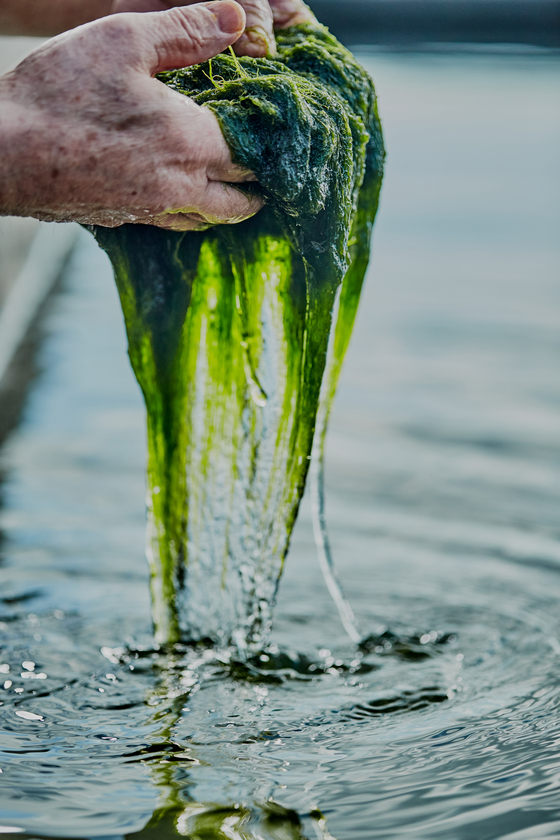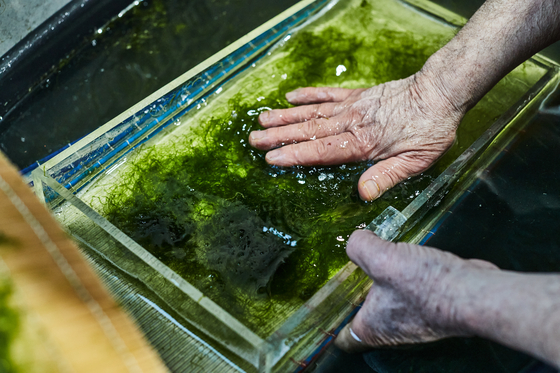Gourmet algae gamtae is the new seaweed on the block
Published: 12 Sep. 2023, 15:50
Updated: 12 Sep. 2023, 15:57
-

- YIM SEUNG-HYE
- yim.seunghye@joongang.co.kr
![Gamtae, a type of seaweed, has captivated the world’s epicures with its rich scent and silky texture. [BADASOOP]](https://koreajoongangdaily.joins.com/data/photo/2023/09/12/8e243688-2f73-4e9d-bf88-b746b7d44f52.jpg)
Gamtae, a type of seaweed, has captivated the world’s epicures with its rich scent and silky texture. [BADASOOP]
Only grown on clean mud flats, this plant is as thin as a piece of string and very sensitive. Every stage of its production is done manually, from harvesting to drying. It goes bad when exposed to high temperatures or the sun for a long period, so it needs to be processed and distributed with care. But the taste makes all the hassle worth it: This is gamtae, or Ecklonia cava, a species of brown algae.
With the aroma of the deep sea, a slightly bitter taste takes center stage at first but soon gives way to a mild sweetness, and its deceptively silky texture tickles the taste buds.
![A gamtae noodles meal kit [BADASOOP]](https://koreajoongangdaily.joins.com/data/photo/2023/09/12/97123860-dfe5-432c-99ae-5d36d8b6f495.jpg)
A gamtae noodles meal kit [BADASOOP]
![Roasted gamtae [BADASOOP]](https://koreajoongangdaily.joins.com/data/photo/2023/09/12/69202507-f7e4-44e6-bbcf-594da1a68fff.jpg)
Roasted gamtae [BADASOOP]
Gamtae stole the limelight overseas first. Michelin-starred restaurants in the United States and Belgium feature gamtae on their menus. Peter Gilmore, a renowned Australian chef, once said gamtae has the aroma of a white truffle. Popular New York-based food website Eater covered gamtae in one of its stories. The seafood was even featured in a French documentary.
Gamtae is available at department stores such as Le Bon Marché Rive Gauche and Galeries Lafayette in France, and retail store city'super in Hong Kong.
![Song Ju-hyeon, CEO of Badasoop [BADASOOP]](https://koreajoongangdaily.joins.com/data/photo/2023/09/12/90b5016b-740b-4b66-82cf-9e127bb3c4ec.jpg)
Song Ju-hyeon, CEO of Badasoop [BADASOOP]
This is all ascribed to Song Ju-hyeon, the CEO of Badasoop.
The 44-year-old businesswoman used to work in the IT sector as a software developer, but eventually quit to join the family gamtae business. She set up factories, got certified by the government’s Hazard Analysis Critical Control Points (Haccp) management system, and visited places connected to gourmet foods such as international food fairs, department stores and hotel restaurants. She believed gamtae could stand next to other luxurious ingredients such as caviar and truffles. Michelin-star chefs were the first ones to pick up on the potential of gamtae.
![Gamtae master Song Cheol-su examines the quality of the end product. [BADASOOP]](https://koreajoongangdaily.joins.com/data/photo/2023/09/12/9a581983-22d2-46d2-aeaf-9f51e3ff2cfa.jpg)
Gamtae master Song Cheol-su examines the quality of the end product. [BADASOOP]
However, Song says she has to attribute all of what Badasoop is enjoying now to her father Song Cheol-su, a gamtae master, who still works at Badasoop.
Song Cheol-su used to sell roasted gim, or laver, after purchasing a seaweed roasting machine from Japan in the 1990s. At its peak, the business saw customers forming a long line within a traditional market to buy his roasted gim. But the business went downhill with the rise of roasting machines. He then had the idea for gamtae. He searched for a good place to grow gamtae by traveling to every nook and cranny of the country, and finally settled down in Seosan, South Chungcheong, at the fertile mud flats. There, he kept searching for ways to produce gamtae and soon began processing it. His years of hard work were acknowledged by Seosan, so the city designated him as a master in gamtae production in 2015. In 2022, he was selected as one of the excellent small business owners by the city. The title is given to those who have managed their businesses sustainably for more than 15 years.
To hear more about the gamtae business, the JoongAng Ilbo, an affiliate of the Korea JoongAng Daily, sat down with Song Ju-hyeon for an interview. The following are edited excerpts.
Q. How do chefs react to gamtae?
A. Gamtae is an ingredient that is difficult to deal with. It can’t be mass-produced like gim, so I thought it would have to be positioned in the category of delicacies. I met Michelin star chefs and explained what gamtae was. They liked the original flavor of it. Corey Lee, the owner-chef of Benu with three Michelin stars, still uses gamtae at his restaurant in San Francisco. In Korea, many chefs such as Jung Ho-young of Caden, Kwon Woo-joong of the three Michelin-starred Kwonsooksoo, and Kang Min-goo of Mingles continue to offer gamtae options at their restaurants.
You wanted to market gamtae as a high-end ingredient. Do you think you’ve achieved your goal?
I would say it is a half success. Fine dining restaurants and five-star hotels use our products. Gourmets and celebrities purchase our gamtae after they taste it. But I think it will take time until it can be considered an everyday food ingredient. That’s because consumers can’t cook gamtae like fine dining eateries do. We work on recipes so that we can offer people ways to enjoy gamtae casually. We aim to promote easy recipes through various channels. It is encouraging that celebrities have come up with recipes using gamtae on cooking shows in recent years.
![Gamtae master Song, left, and CEO Song harvest gamtae on the Garorim Bay in Seosan, South Chungcheong. [BADASOOP]](https://koreajoongangdaily.joins.com/data/photo/2023/09/12/5001c891-5172-4ea6-8cfa-4820c5ad2e0f.jpg)
Gamtae master Song, left, and CEO Song harvest gamtae on the Garorim Bay in Seosan, South Chungcheong. [BADASOOP]
Why do you think you’ve only achieved partial success?
We worked to make gamtae recognizable as a gourmet ingredient but failed to engrave our brand in consumers’ minds. I thought we could promote our brand if we succeeded in promoting gamtae about 10 years ago when it was quite foreign to a majority of consumers. But I was wrong. The price competition has gotten tougher, with more gamtae producers jumping on the bandwagon after they saw its potential. The market has changed. We’re wrestling with big players in distribution, but so far so good. You will see the difference once you taste ours. Our product is produced by a master, and every procedure is managed meticulously. I’m confident that our product is on another level.


![The procedure of preparing gamtae at Badasoop [BADASOOP]](https://koreajoongangdaily.joins.com/data/photo/2023/09/12/29efdc4c-a6fc-43dd-a058-b2da6e13213b.jpg)
The procedure of preparing gamtae at Badasoop [BADASOOP]
What are the best conditions in which to grow gamtae?
They are only grown on mud flats. The Garorim Bay that stretches across Seosan and Taean is about 91 square kilometers (35 square miles). It is the biggest one inland, and was thus designated by the Ministry of Oceans and Fisheries as a marine life protection zone. So there is a slim chance of it getting polluted. Many marine creatures such as spotted seals, which are protected as a natural monument, are found there. Especially when the water temperature is low and the tidal range is greatest, it becomes the perfect habitat for gamtae. When the seaweed is soaked in the water, it absorbs nutrients from the salt water, and when the tide ebbs, it photosynthesizes.
Is gamtae a tricky ingredient to handle?
Most kinds of seaweed are grown on floating rope racks, but gamtae takes root on mud flats. It’s impossible to breed them. Unlike gim, which sticks together easily, it is difficult to shape gamtae into sheets. They are only harvested during winter. The first batch of gamtae in early December has less pigmentation, so it is best suited to be processed for powders. Quality ones with a dark green color are collected after mid-December. After March, it turns yellow and the seaweed loses its taste. Since it is sensitive to temperature changes, a refrigerated warehouse is a must. We store the gamtae harvested last winter in a deep freezer that is set to below negative 20 degrees Celsius [negative 4 degrees Fahrenheit]. Direct sunlight is not good for the product, so we use aluminum packaging. We closely examine the middlemen’s capabilities to store and deliver our products. Otherwise, we can’t serve the best products to our customers.
The whole process of gamtae production is 100 percent manually done. Are there any difficulties in doing it?
About 100 households collect gamtae for us. They say they are glad to work even in the winter, which is usually a slow season for them. Our priority is seeking coexistence with local communities. For this reason, Seosan is supportive of us, helping us find sales channels and export our products. We want to return the support we’ve received from the city.
What is your goal right now?
We’re developing desserts and ready-to-eat meals using gamtae. We will pioneer markets overseas when we finish the project. We’re also thinking about joining hands with various brands as a way of widening the scope of our customers. The most imminent goal for us is marketing our brand as the first brand that people think of when they wonder what to get for families and friends on special holidays like Chuseok and Seollal.
BY SONG JEONG [kjdculture@joongang.co.kr]










with the Korea JoongAng Daily
To write comments, please log in to one of the accounts.
Standards Board Policy (0/250자)